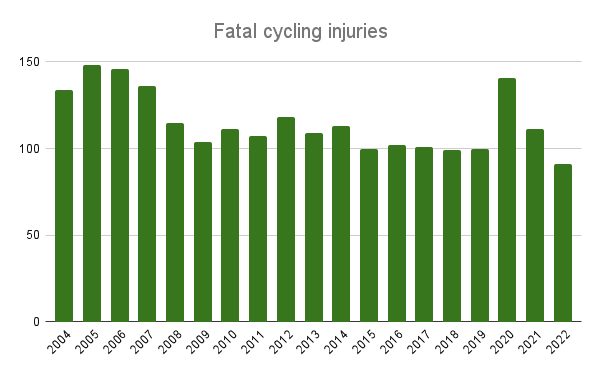If you have been involved in a cycling accident, you may be wondering how often cycling accidents actually occur. You might be curious about whether the rates of cycling accidents have been going up or down recently, or where cycling accidents are more likely to happen.
We have compiled the latest different cycling accident statistics to show you how common road traffic accidents involving pedal cyclists are in Great Britain. We also look at how many cyclists are killed each year in the UK to demonstrate how dangerous cycling accidents can actually be.
Moreover, we tell you what steps you should take if you have been involved in a pedal cycle traffic accident. This section includes what evidence you should collect so that you can potentially prove a cycling accident claim.
If you have been injured in a cycling accident, you might have questions about potentially claiming compensation against another road user. We have a team of advisors who can answer any of your questions regarding cycling accident claims. Here is how you can contact our advisors for free:
- Call 0800 073 8801.
- Start a claim online.
- Message an advisor in our live support chat.

Jump To A Section
- How Many Bicycle Accidents Occur Each Year In The UK?
- How Many Cyclists Are Killed Each Year In The UK According To Cycling Accident Statistics?
- Our Research On Cycling Accident Statistics
- What To Do After A Cycling Accident
How Many Bicycle Accidents Occur Each Year In The UK?
We have taken information from the Government reported road casualties in Great Britain pedal cycle factsheet 2022 to gather the below cycling accident statistics.
The number of reported road casualties for pedal cycle traffic accidents increased by 50% from 2004 to 2022, with the number of serious injuries suffered by cyclists increased by 21% in this same period.
We have created a chart showing the trends in the number of pedal cyclists who were slightly and seriously injured in cycling accidents between 2004 and 2022.
Non-fatal Cycling Injuries Chart

As you can see, the number of serious and slight injuries from a cycling accident peaked in 2014, with 16,203 slight and 4,971 serious injuries. Since then, the number of slight and serious injuries from a cycling accident has been generally declining.
In 2022 alone, there were 4,056 reported seriously injured and 11,546 reported slightly injured casualties. This is the lowest number of reported slight injuries than any other year. That is a combined total of 15,602 cyclists that were non-fatally injured in 2022.
In terms of the types of roads where cycling accidents happen more often, we have taken some cycling accident statistics from 2018-2022 for pedal bike casualties by rural and urban classification. Overall, non-fatal accidents occur most on urban roads, accounting for 75% of serious injuries and 85% of slight injuries. However, 56% of pedal cycle fatalities occur on rural roads. This data suggests that although cycling accidents happen most often on urban roads, rural roads pose a higher risk of death.
If you have been injured in a cycling accident, you can contact a member of our advisory team to learn how we could help.
How Many Cyclists Are Killed Each Year In The UK According To Cycling Accident Statistics?
We have created a chart so you can see the trends in how many pedal cyclists were killed from a cycling accident between 2004-2022.

As you can see, apart from a few fluctuations, the rate of cyclist deaths has slowly declined between 2004 and 2022.
2018 and 2022 were the only years with fewer than 100 fatalities from cycling accidents (99 and 91 road casualties). The number of cycle fatalities in 2022 was 32% lower than in 2004, when there were 134 fatalities.
The years with the highest number of cycle fatalities were in 2005, 2006, and 2020 (148, 146, and 141 road casualties).
Moreover, out of all the cyclists killed and non-fatally injured between 2018-2022, 30% were males aged 40-59. Thus, this was the highest percentage out of any sex and age group. Across all age groups (between the ages of 1-70+), there were 5 times more male casualties for fatal and serious injuries than there were female casualties overall. This data suggests that there are more male cyclists on the road than there are female.
Additionally, between 2018 and 2022, cycling accidents involving 1 car caused the most fatal, serious, and slight injuries, with 64,022 total casualties. Cycling accidents involving one other cyclist caused the least amount of casualties (872 total).
If a loved one’s death was caused by a bike or cycling accident, you can contact our advisors to see how we may be able to help you.
Our Research On Cycling Accident Statistics
We have done some independent research of our own, looking into the areas within the UK with the most cyclist fatalities caused by a car between 2020-2023:
- West Midlands – 61%
- Scotland – 7%
- Hertfordshire – 6%
- Greater London – 5%
- Greater Manchester – 5%
As you can see, between 2020 and 2023, the West Midlands was where the most fatalities happened from cycling accidents.
The research is based on the responses to Freedom of Information requests that we made to all police forces in the UK. The results above are based on those who have responded to those requests. If you would like to see the raw data, please get in touch.
What To Do After A Cycling Accident
Following a cycling accident, there are certain steps you should take. Additionally, some of these steps could help you with making a personal injury claim. These steps include:
- Recording the date, time, and location of the accident.
- Record the names and details of the parties involved in the accident.
- If there were any witnesses, record their names and details. A statement could be taken from them at a later date.
- Take photographs of the accident scene and any visible injuries you suffered,
- Request CCTV footage of the accident. You can also request dash-cam footage from a car that captured the accident.
- Record if the police attended the accident and make a note of the police reference number.
- Seek medical care for your injuries and ask for copies of your medical records. These records could be used as medical evidence regarding the severity of your injuries and what treatments you require.
- Keep note of your symptoms and treatment in a diary.
- Keep any receipts, payslips, invoices, etc., that you may have that show how your accident has affected you financially. For instance, if you have incurred a loss of earnings your payslips could help with proving this.
- Have a chat with us to see whether you may have a valid personal injury claim. If so, we could connect you with one of our expert solicitors.
If the road traffic accident claims process seems daunting to you, don’t worry. We can help. As part of their service, our specialist solicitors help their claimants to collect the evidence they need to help prove their case.
Contact Us
Have a chat with us about your circumstances if you think you might have an eligible pedal cycle accident claim. If you are eligible to claim compensation, our specialist No Win No Fee cycling accident solicitors may be able to help. They could offer their services to you through a Conditional Fee Agreement. With this particular arrangement in place, some of the benefits include:
- Nothing to pay for your solicitor to begin working on your case.
- No ongoing service fees.
- Nothing to pay for your solicitor’s services if the claim is unsuccessful.
- Paying a legally-limited percentage from your compensation to your solicitor if your claim is a success. This is called a success fee.
Our contact details are live 24/7 so you can contact us at a time that suits you:
- Call 0800 073 8801
- Start a claim online.
- Message an advisor in our live support chat.

Discover More About Claiming For Cycling Accidents
Here are some of our other guides on cycling accident claims:
- See how you can potentially claim compensation for the death of a family member if someone you know has been involved in a fatal accident.
- Find out whether you could make a personal injury claim against a cycling activity centre.
- What to do if you have had a cycling accident on a roundabout and find out who could be at fault.
Additional information can also be found on these other pages:
- Gov.UK – The Highway Code, which provides road safety rules for cyclists, motorists, and pedestrians.
- Think! – a Government road safety campaign that provides advice for cyclists on injury prevention.
- NHS – advice on how to cope with grief after a loss if you have lost someone to a fatal biking accident.
Thank you for reading our trends and cycling accident statistics guide. Contact our advisors today to see how we may be able to help you if you have been involved in a cycling accident.



